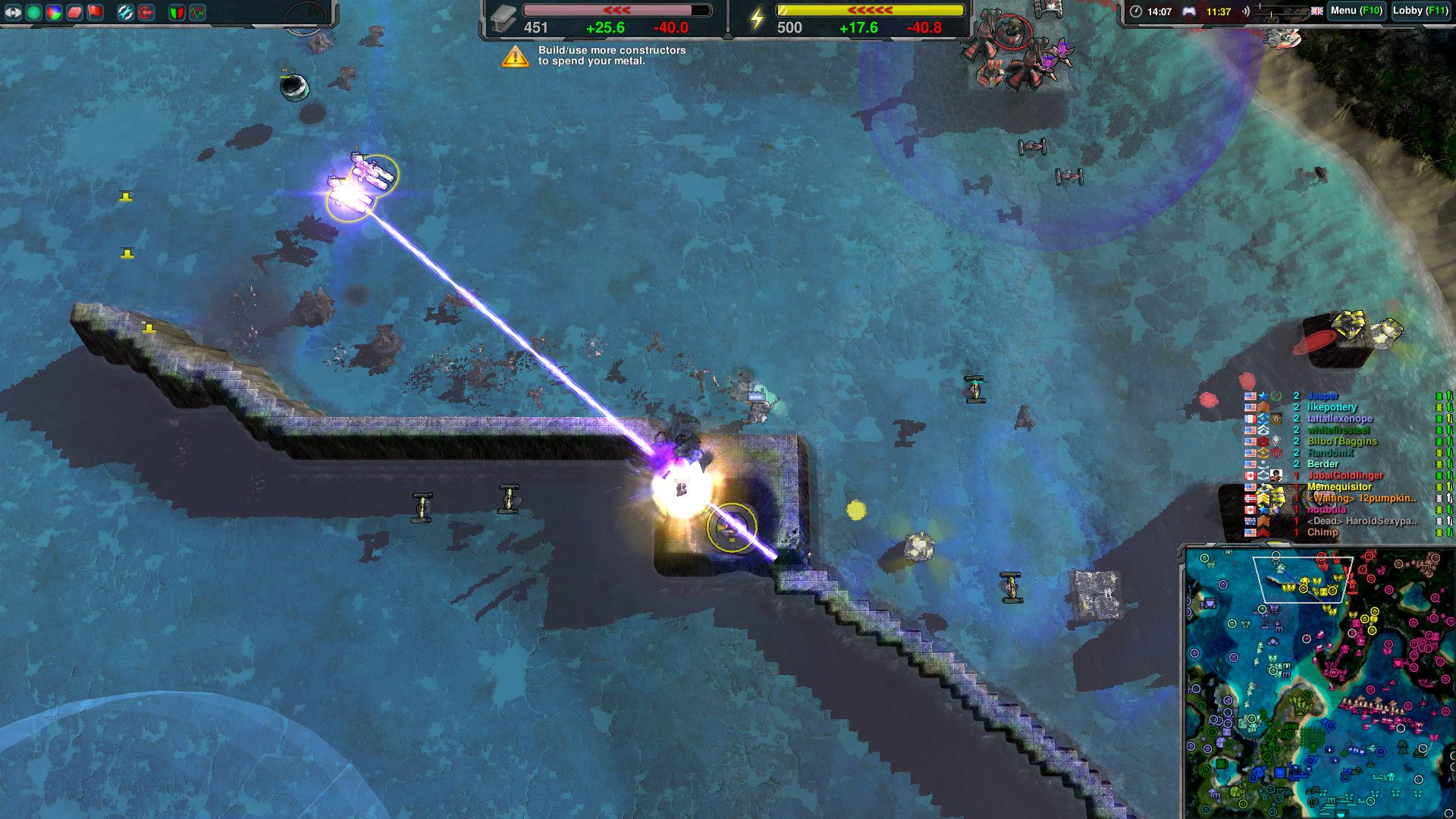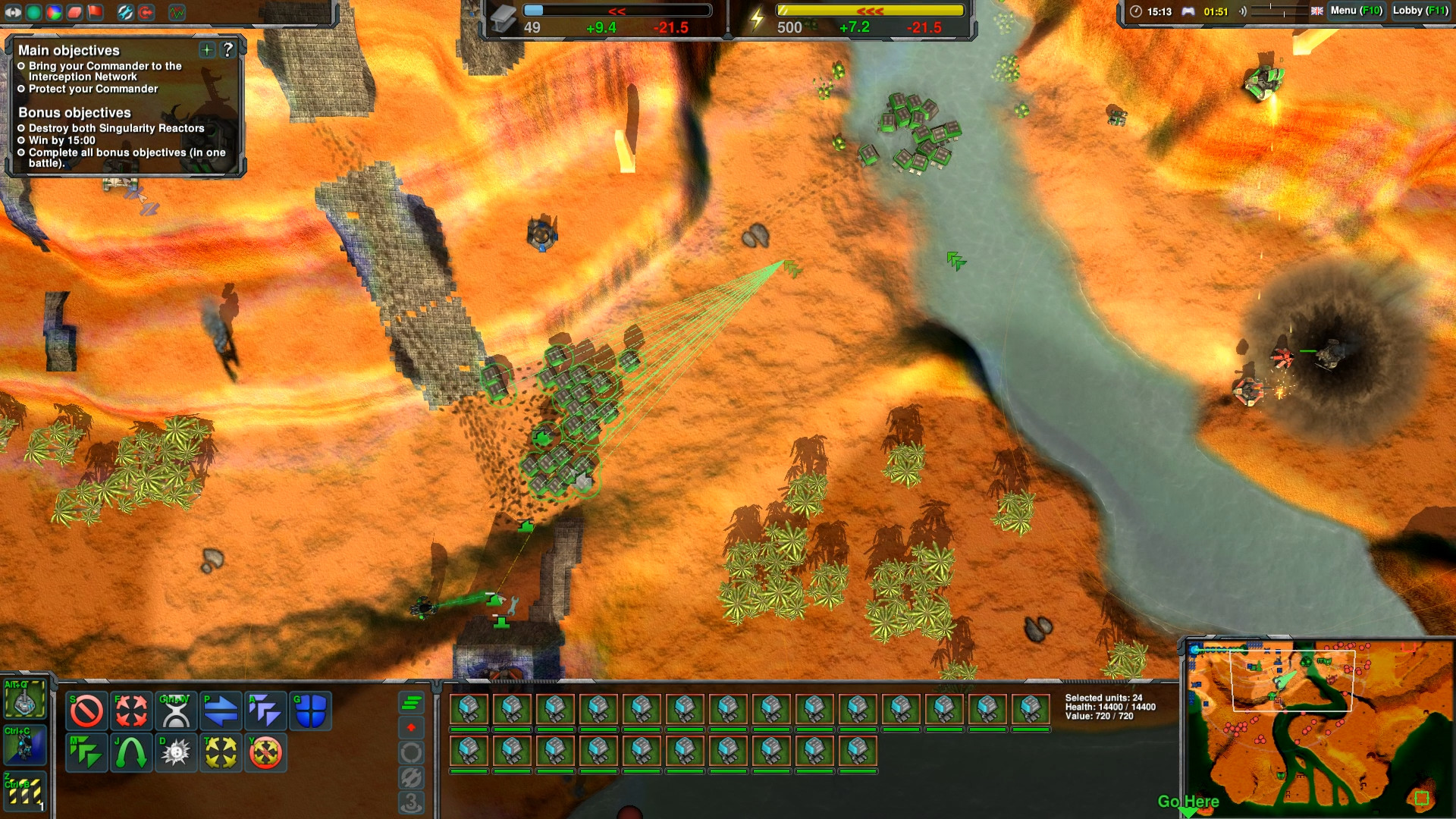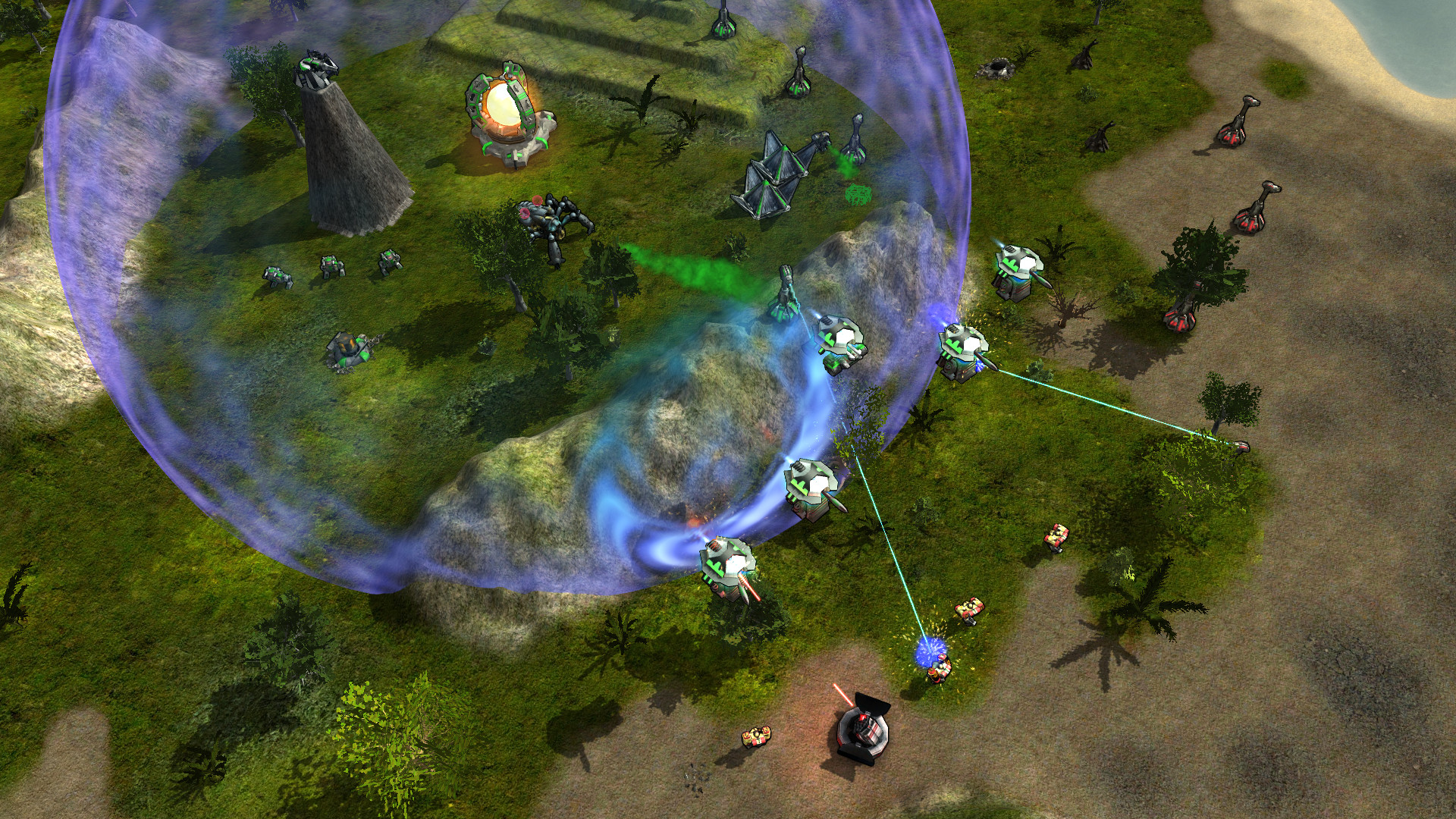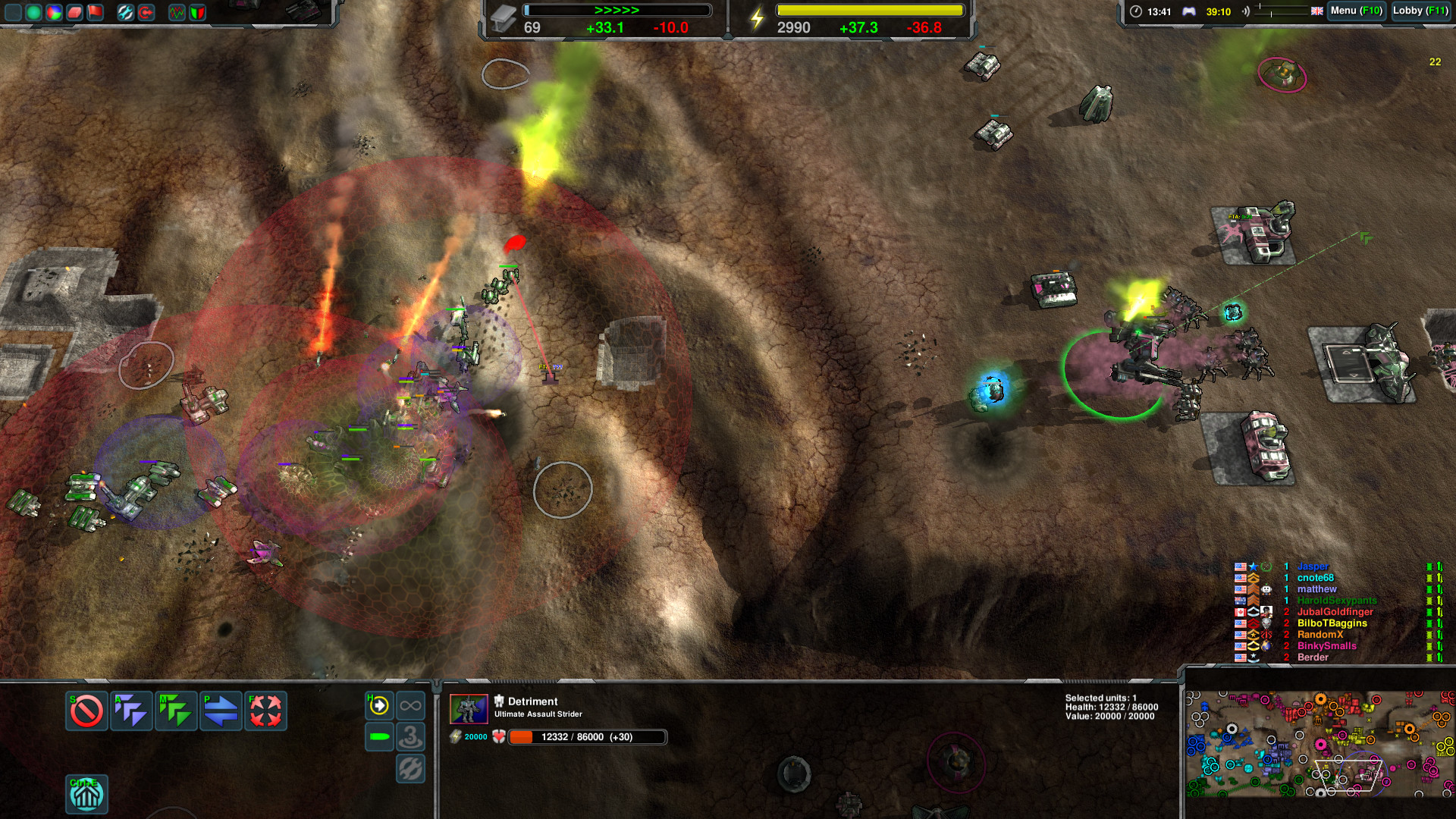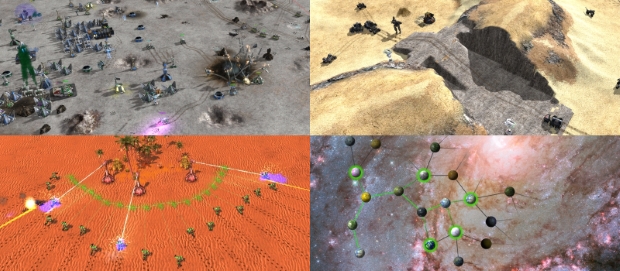
Commander wanted! Construct giant robots, build an army of a thousand Fleas. Move mountains if needed. Bury the enemy at all cost!
- Traditional real time strategy with physically simulated units and projectiles.
- 100+ varied units with abilities including terrain manipulation, cloaking and jumpjets.
- 70+ mission galaxy-spanning campaign to be enjoyed solo or co-op with friends.
- Challenging, (non-cheating) skirmish AI and survival mode.
- Multiplayer 1v1 - 16v16, FFA, coop. ladders, replays, spectators and tournaments.
- PlanetWars - A multiplayer online campaign planned to start in May.
- Really free, no paid advantages, no unfair multiplayer.
Fully Utilized Physics
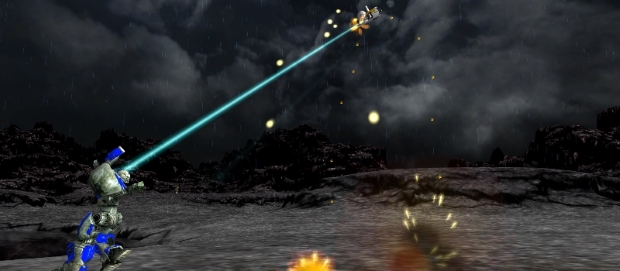
Simulated unit and projectile physics is used to a level rarely found in a strategy game.
- Use small nimble units to dodge slow moving projectiles.
- Hide behind hills that block weapon fire, line of sight and radar.
- Toss units across the map with gravity guns.
- Transport a battleship to a hilltop - for greater views and gun range.
Manipulate the Terrain
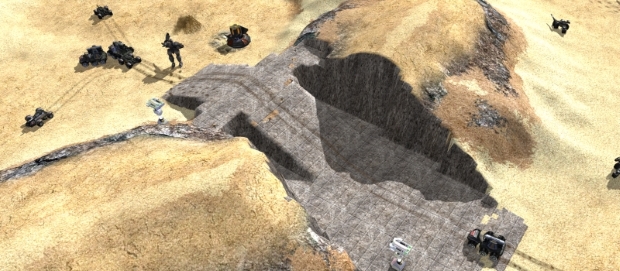
The terrain itself is an ever-changing part of the battlefield.
- Wreck the battlefield with craters that bog down enemy tanks.
- Dig canals to bring your navy inland for a submarine-in-a-desert strike.
- Build ramps, bridges, entire fortress if you wish.
- Burn your portrait into continental crust using the planetary energy chisel.
Singleplayer Campaign and Challenging AI

Enjoy many hours of single player and coop fun with our campaign, wide selection of non-cheating AIs and a survival mode against an alien horde.
- Explore the galaxy and discover technologies in our singleplayer campaign.
- Face a challenging AI that is neither brain-dead nor a clairvoyant cheater.
- Have some coop fun with friends, surviving waves of chicken-monsters.
- Cloaking? Resurrection? Tough choices customizing your commander.
Casual and Competitive Multiplayer
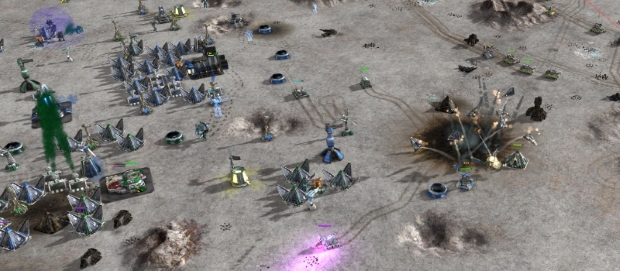
Zero-K was built for multiplayer from the start, this is where you can end up being hooked for a decade.
- Enjoying epic scale combat? Join our 16v16 team battles!
- Looking for a common goal? Fight AIs or waves of chicken-monsters.
- Prefer dancing on a razor's edge? Play 1v1 in ladder and tournaments.
- Comebacks, betrayals, emotions always running high in FFA.
- Want to fight for a bigger cause? Join PlanetWars, a competitive online campaign with web-game strategic elements, diplomacy and backstabbing (currently on hiatus pending an overhaul).
Power to the People

We are RTS players at heart, we work for nobody. We gave ourselves the tools we always wanted to have in a game.
- Do what you want. No limits to camera, queue or level of control.
- Paint a shape, any shape, and units will move to assume your formation.
- Construction priorities let your builders work more efficiently.
- Don't want to be tied down managing every unit movement? Order units to smartly kite, strafe or zig zag bullets.
Plenty of Stuff to Explore (and Explode)
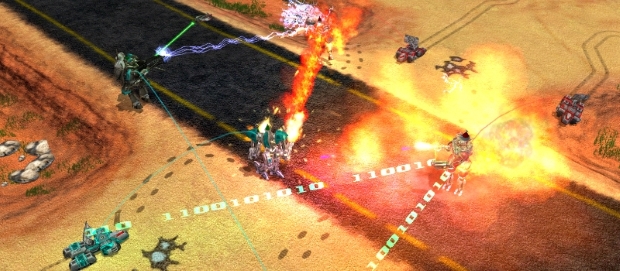
Zero-K is a long term project and it shows, millions hours of proper multiplayer testing and dozens of people contributing ever expanding content.
- Learn to use all of our 100+ units and play on hundreds of maps.
- Invent the next mad team-tactics to shock enemies and make allies laugh.
- Combine cloaking, teleports, shields, jumpjets, EMP, napalm, gravity guns, black hole launchers, mind control and self-replication.
- Tiny flea swarm that clings to walls?
- Jumping "cans" with steam-spike?
- Buoys that hide under water to ambush ships?
- Mechs that spew fire and enjoy being tossed from air transports?
- Carrier with cute helicopters?
- Jumping Jugglenaut with dual wielding gravity guns?
- Meet them in Zero-K!
Raven was arguably the single most influential unit in Zero-K, and is definitely the most reworked. As the main bomber for 15 years, its burst damage defined the health thresholds that determined vulnerability to air. I say was because the bomber lineup has since been fleshed out, with the addition of Magpie and Odin , as well as the de-Owling of Phoenix. But that is only the end of the story, after many tweaks and redesigns. The full story is of a conflict between physics and reliability, and involves Raven trying almost as many weapons and abilities as the rest of the bombers combined.
Early Raven
The proto-Raven was inherited from Total Annihilation (via BA) , and was originally the generic light bomber. It was generic in the sense of being a weaker and cheaper version of the heavy bomber. This was not good enough, we wanted units with roles rather than generic monospam , so the first order of business was to make these two bombers distinct. We also wanted the light/heavy bomber divide to fit into our fuzzy approach to tech levels , so if the heavy bomber was to take over later in the game, it should be because the situation has changed, not because it just has better stats.
Our solution was to give the heavy bomber more bombs, to create a real carpet bomber, while the light bomber was pared down to drop a single, precise, bomb. Raven was born, and in a sense, so was Phoenix, although Phoenix ended up much closer to the old heavy bomber. Here is the theory behind the role split.
- Carpet bombing is great against clumped armies, which are more prevalent later in the game.
- Precision bombing is great at taking out key units, such as turrets, riot units, and commanders, and individual kills have more impact early in the game.
A commander sniper needs to know how many bombers are required to kill a commander. Too few, and the commander survives and is repaired, wasting all the bombers that died in the attempt. Too many, and the attempt is delayed, giving anti-air more time to build up. Shooting a spray of bombs, like the original light bomber, makes the outcome somewhat random. Perhaps four bombers only have an 80% chance of firing a tight enough spread of bombs, so you need to bring a 5th one to bump the chance of a kill up to 99%. This level of randomness felt bad.

To be more precise, randomness can be split into two types: output randomness and input randomness. This concept has been blogged to death elsewhere , so in short:
- Input randomness is where something random sets up a situation, then you make decisions about how to deal with it. Think random map generation.
- Output randomness is where you make a decision, then a random process determines the outcome. Think rolling to hit in X-Com, D&D, or Starcraft.
Weapons Development
The theory behind precise Raven was sound, but we failed to account for one thing: commanders can move. Commanders do not enjoy being sniped, so move out of the way when bombs are lobbed at them. In fact, Raven could not even hit commanders walking in a straight line, since the default bomber weapon type does not lead targets. This is an engine limitation that stems from the fact that bombs inherit the velocity of their bomber. Bombs are not fired, they are dropped. This ties aiming to movement, and no one was game enough to figure out target leading with this complication. So Raven needed a new weapon.

The first rework came about due to Complete Annihilation being a collection of contributors doing cool things, rather than by design. Someone woke up one day and thought "All the Arm bombers should shoot laser", so all the Arm bombers shot lasers. Phoenix was light show, Likho abducted units with a thick purple beam, and Thunderbird shot a spray of lightning rather than cluster of Imp-like bombs. Only one of these changes stood the test of time. As for the Raven-equivalent bomber, it shot a short burst straight down, like an awkwardly airborne Grizzly.
Lasers highlighted, rather than fixed, the problem with pure movement-based aiming. Laser Raven had perfect accuracy against anything directly beneath it, but again, commander can move. Even a slow commander could walk sideways fast enough to overwhelm the Raven's ability to turn and correct. The angular velocity of a dodging commander increases dramatically as Raven gets closer, necessitating a ridiculous turn rate that would make Raven behave more like a figure skater than an aircraft. We were too committed to planes that behave somewhat like real planes, so went back to the drawing board.

With lasers out, we looked to rockets. Technically, rockets have cylindrical range so a short-ranged rocket would be able to fire at targets far below. Verisimilitude has a few things to say about this hack, but it mostly works. Lingering issues were fixed by moving the firing point along the underside of the wing, towards the side that the target is on. The result was a Raven that could be relied upon to shoot and hit a commander walking in a straight line, even a perpendicular one. However, curved lines were another matter.
Target leading works by predicting where a unit will be based on its velocity. It cannot take into account turning, because a unit could choose to turn at any time. The result was the Raven "quick time event", where players would tell their commander to do a little dance, or just walk in circles, whenever a Raven fired at it. We made the rocket-bomb fast enough to make dodging non-trivial, but we were limited by trying to avoid Raven being too good against fast units. The ideal was a Raven that could reliably hit slow units, without massacring medium raiders. A solution to this conundrum came in the form of a new ability: diving.
The Decade of Dive
Dive started off as an unrelated attempt to resolve a fight with the UI . I had noticed three things:
- Raven has enough damage to 1-shot large shield generators.
- Raven flies slightly higher than the shield, which can absorb many bombs.
- Landing brings bombers closer to the ground.

The result was immediate, people started telling Raven to fly lower to score more hits on commanders, significantly increasing their reliability. The default behaviour was subsequently updated to make Raven dive when attacking mobile targets, and they even modulated their height by the speed and size of the target. The mechanic had the neat side effect of making Raven more vulnerable to return fire against faster units, and slowing down the bomb accentuated this aspect. Eventually we made Raven slow down as it dove, making it particularly vulnerable to fast raiders. This was Raven for over a decade, from 2011 to 2022, but it was not a solution without problems.
The first problem was that dive is a complicated and powerful ability. Raven had the implied ability to choose its altitude from moment-to-moment, trading off against speed, so that is what the unit AI used. This turned it into effective anti-air as it could fly to the generally-static height of other aircraft and spawn bombs inside them, for massive damage. We eventually added an arbitrary target restriction to prevent this for non-gunships, but needing to do this is a red flag. On the complication side of things, Raven gained many ways to be stupid , such as diving too low too early against particularly fast raiders, and never catching them.
The second problem was visual. Raven diving down to engage speedy units in melee looks a bit silly. Especially with its relatively wide model. Flying low also looks weird around uneven terrain, since Raven has to climb quite steeply to avoid bumping into it. So, after a decade of dive, we gave the idea of firing from cruising altitude one more try.

The Gliding Bomb
The final rework resulted in one of the more complicated weapons in Zero-K, especially compared to how important it is for players to understand in detail. But each detail solves a specific problem, so here we go.
Modern Raven shoots a homing missile, but unlike other missiles, this one is constrained to only ever point in the approximate direction of the ground. The result is a sort of guided "parachute" bomb that manoeuvre itself to hit anything within a cone below it. The firing logic takes the speed of the bomb and angle of the cone into account when determining the likelihood of a hit. Structures will be shot at maximum range, while slow units can be shot at a slightly reduced range. There is a minimum firing range, to avoid the Laser Raven problem, and quick raiders can even outrun the bomb. Raven still tries to hit raiders, as not doing so could look like a bug, and it can always be used as a zoning tool in an active battle.

We finally have a Raven that can be relied upon to shoot at and hit a commander, with the exception of the jump Recon commander, but it pays for this ability with reduced health. Speaking of which, jumpets and Raven grapple with similar design issues, as they can create high-swing outcomes. The difference is that jumpjets started off reliable, and we had to resist adding jank, while precision bombing is inherently difficult, so it took many years to find a solution that is both reliable and physically sensible.
Raven is too big for one post, so expect more Raven facts in the future, such as why bombers need to reload, or why terraform necessitates the inclusion of a bomber that can shoot underwater and straight down.
Index of Cold Takes

Minimum Setup
- OS: Ubuntu 13.04 or equivalent
- Processor: 2.0 GHz dual core CPU with SSE (Intel Core 2 Duo or equivalent)Memory: 4 GB RAM
- Memory: 4 GB RAM
- Graphics: 512 MB graphics card with OpenGL 3 support (GeForce 8800 or equivalent)
- Storage: 6 GB available spaceAdditional Notes: 64bit only. Big Picture mode is not supported
Recommended Setup
- OS: Ubuntu 17.10 or equivalent
- Processor: 3.0 GHz quad core CPU (Intel Core i5 or equivalent)Memory: 8 GB RAM
- Graphics: 2048 MB graphics card with OpenGL 3 support (high GT 500 series or equivalent)Network: Broadband Internet connection
- Storage: 8 GB available spaceAdditional Notes: 64bit only. Big Picture mode is not supported
[ 6444 ]
[ 2268 ]
[ 1913 ]


